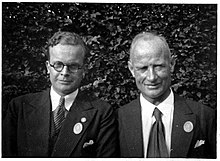Otto Ruff
Otto Karl Ruff (born December 30, 1871 in Schwäbisch Hall , † September 17, 1939 in Breslau ) was a German chemist .
Life
Ruff was the son of the engineer and railway councilor Wilhelm Ruff and his wife Emilie Dieterich. He passed his Abitur in Schwäbisch Hall in 1889 and began an apprenticeship as a pharmacist in the Neckar pharmacy in Stuttgart, studying chemistry with Carl Magnus von Hell at the TH Stuttgart . After the pharmacist's assistant exam in 1891, he went on a journey to pharmacies in Germany, Switzerland and England. From 1894 he studied chemistry and pharmacy at the University of Berlin, passed the state examination as a pharmacist in 1896 and received his doctorate there in 1897 under Oskar Piloty . He then worked as an assistant in Emil Fischer's institute . In 1901 he completed his habilitation, was then a private lecturer and in 1902 took part in a summer course on physical chemistry with Wilhelm Ostwald in Leipzig. In the same year he was appointed head of the inorganic department of the 1st Chemical Institute of the University of Berlin, headed by Fischer, and in 1903 appointed professor. At that time he was working on halosulfur compounds. In 1904 he became a professor for inorganic chemistry at the newly founded Technical University of Danzig . There he turned to fluorine chemistry, but also undertook experiments on high-temperature chemistry (diamond synthesis). In 1916 he became Professor of Inorganic Chemistry at the University of Breslau and Director of the Institute for Inorganic Chemistry there. In 1937 he retired.
In 1902 he married the pharmacist's daughter Meta Richter, with whom he had three children.
plant
His fields of work were first in organic chemistry. The Ruff breakdown of carbohydrates , which he described in 1898, is named after him. From 1902 he turned to inorganic chemistry and especially fluorine chemistry , which he decisively promoted. He synthesized numerous fluorine compounds for the first time, such as uranium hexafluoride , molybdenum hexafluoride, 1904 antimony pentafluoride , a strong Lewis acid and part of the magic acid , trifluorosilane , arsenic pentafluoride and nitrosyl fluoride . Further compounds were added after he was able to burn fire and fluorine- proof vessels made of fluorspar , for example fluorine compounds of platinum, hexafluoroazomethane and trifluoronitrosomethane .
Honors and memberships
The Association of German Chemists awarded him the Liebig Medal in 1930 . In 1926 he received an honorary doctorate from the TH Dresden.
In 1933 he was elected a member of the German Academy of Sciences Leopoldina and in 1931 a member of the Göttingen Academy of Sciences . In 1934 he became a member of the National Academy of Pharmacy in Madrid.
literature
- Claus Priesner: Ruff, Otto Karl. In: New German Biography (NDB). Volume 22, Duncker & Humblot, Berlin 2005, ISBN 3-428-11203-2 , p. 233 ( digitized version ).
Fonts
- The chemistry of fluorine, Springer 1920
- Introduction to the chemical internship for students of chemistry and metallurgy, revised by Hans-Albert Lehmann, Akademische Verlagsgesellschaft, Leipzig 1952, 1961
Web links
- Chemistry friends Erkner
- Literature by and about Otto Ruff in the catalog of the German National Library
- Department of Inorganic Chemistry, Chemical Faculty, Gdańsk University of Technology: Heads of Department of Inorganic Chemistry since 1904 , Otto Ruff (1871–1939).
Individual evidence
- ↑ Otto Ruff: About some new fluorides , in: Chem. Ber. , 1909 , 42 (1), pp. 492-497; doi : 10.1002 / cber.19090420175 .
- ↑ Otto Ruff, Alfred Heinzelmann: About the uranium hexafluoride , in: Journal for inorganic chemistry , 1911 , 72 (1), pp. 63–84; doi : 10.1002 / zaac.19110720106 .
- ↑ Ruff, Wilhelm Plato, About the representation and physical properties of some new fluorine compounds. Titanium tetrafluoride, tin tetrafluoride, antimony pentafluoride, as well as mixed antimony trifluorides and pentafluorides. (In part jointly with Mr. Hugo Graf.), Reports of the German Chemical Society, Volume 37, 1904, pp. 673-683.
- ^ Member entry by Otto Ruff at the German Academy of Natural Scientists Leopoldina , accessed on June 23, 2016.
- ↑ Holger Krahnke: The members of the Academy of Sciences in Göttingen 1751-2001 (= Treatises of the Academy of Sciences in Göttingen, Philological-Historical Class. Volume 3, Vol. 246 = Treatises of the Academy of Sciences in Göttingen, Mathematical-Physical Class. Episode 3, vol. 50). Vandenhoeck & Ruprecht, Göttingen 2001, ISBN 3-525-82516-1 , p. 207.
| personal data | |
|---|---|
| SURNAME | Ruff, Otto |
| ALTERNATIVE NAMES | Ruff, Otto Karl |
| BRIEF DESCRIPTION | German chemist |
| DATE OF BIRTH | December 30, 1871 |
| PLACE OF BIRTH | Schwäbisch Hall |
| DATE OF DEATH | September 17, 1939 |
| Place of death | Wroclaw |
